Abstract
The role of social media in academic settings has increased manifold. Both the teachers and the learners inside as well as outside classrooms use social media for different academic purposes. The present study was conducted to research to what extent the use of social media has become a fast way of material development in Pakistani ELT setting. Generally, social media is being used for getting and sharing information through different social media platforms: Facebook, whatsapp, YouTube along with other websites. The question is how social media is being used one of the medium for the development of material for four language skills? The data was collected through two major sources of survey and interviews from both the teachers and the learners. The data was analyzed quantitatively and qualitatively to reach the results. The findings answered the question that social media can be used as a source of material development in Pakistani ELT settings. This research will open the doors of further explorations in the same domain.
Key Words
Social Media, English Language, ELT, Undergraduate Levels, Whatsapp, Facebook
Introduction
In the current era, use of social media has become a prominent and integral part of academic settings. Social media usage has increased its impact on individual as well as on institutional levels. The role of social media has received praise and criticism simultaneously. Some favour it as useful source and resource for academic purposes while others consider it confusing and waste of time. The connectivity of an in individual with the whole globe of the world is based on the use of social media nowadays. Learners spend more time on social media and very less time in interaction with real people in real situations which creates a huge impact on their communication skills (Abbas,
Aman, Nurunnabi, & Bano 2019). Whatever the debate may be, use of social media has occupied a significant place in academic worlds around the globe and Pakistan is no exception. The paradigm of ELT classrooms has shifted from traditional teacher-dependence to individual independence. Babbie (2015) pointed out the fact that learners are being affected by social media. It effects essentially on the lives of students of graduation level in their grades. Social media has been used for teaching and learning four language skills. Namaziandost & Nasri (2019) research, learners can improve their language abilities due to the many channels that social media has provided. This is proven these days.
Background of Study
In present times, the excess usage of social media for all possible fields of human affairs including academic purposes is undeniable. However, there is a kind of a controversy or a debate about social media usage in English language teaching & learning in Pakistan also in some other countries that whether it is useful or not? There are two different opinions in this regard can easily be categorized in two ways, one is against and the other is in favour of use of social media. Talking about the use of social media in Pakistani academic scenario, it can be stated that though social media is being used in English language teaching and learning yet it is not well-ordered and well-designed. Consequently, it seems difficult to give one opinion. It varies from person to person, place to place, institution to institution and policy to policy. The primary debate is the controversy basically, that use of social media in educational purpose that’s why to use social media and why not to use and why social media? The present study was being conducted to find that whether the use of social media is a useful source of material development for English language teaching and learning or why? Social media for ELT classrooms material development can be used in two broader ways: first as a source of inspiration to observe how others work and use social media for academic purposes and second how one can design and upload customized material. The means social media will certainly offer platforms for individuals to create and share ELT academic material for individual as well as collective benefits. This activity will motivate others and in this way a change will sure occur from dependent to independent teaching and learning in ELT classrooms. The use of social media for teaching learning of English language material development can be made effective source of sharing personally designed material. For instance, any ELT teacher and learner can create a Facebook page, WhatsApp group and a YouTube channel based on personally designed material. This will serve as sources of information and inspiration. It seems easy to agree that ELT teachers and learners need customized material in accordance with their needs, therefore, any material development activity will serve individual and collective purposes and solve individual and collective problems of searching and using ELT material. The five major ELT teaching learning domains are four skills of language: reading, writing, listening & speaking and grammar skills. The teachers and the learners are found worried about material for teaching leaning these skills in ELT classrooms in Pakistan. In spite of availability of bulk material the confusions and problems remain unanswered and unsolved. The most suitable answer is customized material development by ELT teachers and learners. As the modern world has changed with the passage of time so have the channels of communication similarly ELT practices have also undergone notable changes from teachers and only books as sources of knowledge to digitalization.
Rationale
The most dominant role of social media in academic settings has raised many researchable aspects. The present study was conducted with the purpose to explore and analyse the possible use of social media as a source of material development for English language teaching and learning. It was observed that along with in-class traditional teaching learning practices the role and dependence of social media was increasing gradually in Pakistani ELT classrooms both by the teachers and the learners. The study focused on finding answer to the question to what extent social media can be used as a source of material development for English language teaching and learning.
Delimitations
The study in hand will focus only on four language skills of listening, speaking, reading and writing.
Hypothesis
H0 Use of social media is not significant as a source of material development for English language teaching and learning.
H1 Use of social media is very significant as a source of material development for English language teaching and learning.
Significance of Study
This study has the following significant features:
? Offer guidelines for an effective use of social media as a reliable source of material development for English language teaching and learning by removing the negative concepts that social media is waste of time and only a source of copying and cramming available material.
? Customized material development can be done by both the teachers and the learners in ELT classrooms for English language teaching and learning purposes.
? Modernization and updating of English language teaching classrooms is possible by showing the teachers and the learners to use modern academic facilities.
? Most frequent effective social media platforms like Facebook, Whatsup, Youtube, online classroom Apps: zoom and Google classroom may be used from a new perspective of developing ELT material by the teachers and the learners.
? Create independent teachers and learners by offering them a new direction of use of social media.
Objectives of Study
The study in hand is meant to determine the following objectives:
? To tract the current use of social media in English language teaching for academic purposes
? To trace the opposition and the challenges of social media use in English language teaching
? To explore possibilities of well-ordered and well-designed use of social media in English language teaching.
Populations
All the ELT Teachers of Public and Private Institutions at Undergraduate Levels
All the ELT Students of Public and Private Institutions at Undergraduate Levels
Literature Review
Social media usage is immensely increasing as the aim of facilitation in learning, communication and information technology by educational institutions and general public these days. In educational setup, social networking sites are regarded important in learning a language.
Lin et al. (2016), social media, such as Facebook, Twitter, and YouTube, not only give users the possibility to generate information but also to share it with other users around the globe. In light of the fact that students are prepared for technological advancements in education, higher education institutions should use their capacity to better meet the creative requirements of their students (Akhiar, Mydin, & Kasuma, 2017). In the current era, social networking platforms like Whatsapp, Instagram, Twitter, Facebook & Youtube provide scaffoldings for university students with high rate of demography (Gettman and Cortijo, 2015) therefore mobile learning tools provide positive influence in language learning. English is an official language in most of the countries of the world for example in Jordan traditional ways of rote learning reduced English language learning. Students not come up to scratch language competency as it depends on lecturing too; a great extent in the traditional chalk and talk procedure (Al-Jarrah et al., 2019; Gillett, 2009). This type of procedures and instructing content makes the learning a tedious action and generate repugance between pupils by decreasing them to just passive receptors of a language rather than active participant in learning procedure (Sumathi, 2016). Students are impotent to completely understand speech and not even willingly take part in classroom discourse and therefore they have limited opportunities to use English in communication and are helpless to communicate in self centered written work (Gilakjani & Ahmadi, 2011). From many years, these social media platforms have become immensely emerged among societies, especially among young generation. The reason behind their exclusive affordances is the provision of such applications which are user-friendly, communicative, and collaborating (Greenhow et al., 2019; 2011; Kent & Leaver, 2014). Social media is constantly changing the way people live in different aspects. Nowadays, various social media platforms are affecting communication, information delivery, knowledge exchange, commerce, education and all different aspects of life (Rieger and Christoph, 2018; Bhatti et al., 2019; Amin et al., 2020).
The term social media is predominantly used to narrate mechanization system associated with community (Josten, 2012) that particular elucidation (Kaplan & Haenlein, 2010), social platform frequently used for social media sites like Facebook whatsapp twitter and youtube. A comprehensive definition of social media such as synergic online applications and networking sites motivate and facilitate for taking part in discussions participations suggestions and socializations amid community of users ( Bowley, 2009:15), allows web-based gadgets and applications to support such activities on a person-to-person basis (Storey et al, 2010). Social media is a powerful tool which provides information and brings peoples to exchange their ideas in an open way social networking sites provides an open door to all in the whole world. A lot of investigatios on students educational achievemens have been found that results positive and negative consequences. In Mushtaq 2018, claimed that usage of social media networking sites could be a good source towards educational exasperation especially when students associate with other students that have same issues it will permit them to talk about class distress along social media platforms. Facebook Instagram WhatsApp and Twitter now a days provide scaffolding for University students with high rate of demography (Gettman and Cortijo, 2015) therefore mobile learning tools provides positive influence in language learning.
Research Design
This study is a pure research which will explore the significance of the usage of social media for ELT, data collection sources are: journals, books articles circulated in the similar fields. Data is collected from the teachers and students of English Language Teaching in public and private educational institutions in the different districts of Punjab province.
Data Collection
Data was collected through two major sources of survey questionnaire and interviews.
Data Analysis
Data was analysed both quantitatively and qualitatively through survey of questioner and interview
Quantitative Data Analysis of Survey Questionnaire
Data analysis of survey is given here:
Figure 1
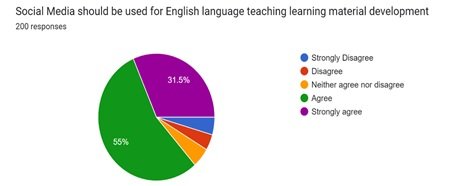
In response to the question statement that ‘Social media should be utilized for English language teaching erudition material development’, the above chart shows the results of 200 responses 4.0% respondents respond with strongly disagree option, 4.5% respondents responded with the option disagree, 5.0% respondents responded with the option neither agree nor disagree, 55.0% respondents responded with the option agree and 31.5% respondents responded with the strongly agree. The results show that 8.5% participants disagree with this assertion, 86.5% interlocutor agree with the statement while 5.0% respondents remain neutral. The results confirm that majority of respondents agree that social media gadgets must be used for English language learning and teaching material development. This is a positive sign for using social media for English language teaching and learning for material development.
Figure 2
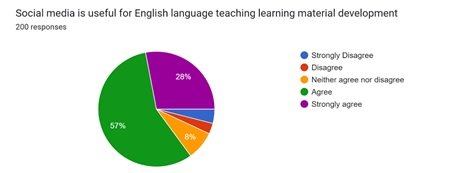
Inside the response to the question statement that ‘Social media is useful for English language teaching learning material development’, the above chart shows the results of 200 responses 3.0% respondents respond with strongly disagree option, 4.0% respondents responded with the option disagree, 8.0% respondents responded with the option neither agree nor disagree, 57.0% respondents responded with the option agree and 28.0% respondents responded with the strongly agree. The results show that 7.0% respondents disagree with the statement, 85.0% respondents agree with the statement while 8.0% respondents remain neutral. The results confirm that majority of respondents agree that social media usage for English language learning and teaching for material development is useful. This is a positive sign for the use of social media for English language coaching and gaining knowledge for material development.
Figure 3
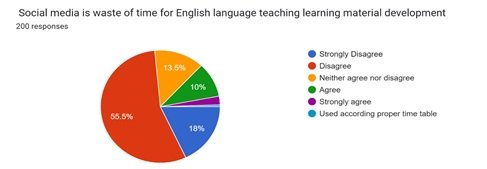
In response to the question statement that ‘Social media is a waste of time for English language teaching learning material development’, the above chart shows the results of 200 responses 18.0% respondents respond with strongly disagree option, 55.5% respondents responded with the option disagree, 13.5% respondents responded with the option neither agree nor disagree, 10.0% respondents responded with the option agree and 3.0% respondents responded with the strongly agree. The findings shows that 73.5% participants disagree with the assertion, 13.0 participants agree with this assertion while 13.5% respondents remain unbaised. The results confirm that majority of respondents disagree that social media is a waste of time for English language teaching and learning material development that shows positive sign towards social media usage for English language learning and teaching material development.
Figure 4
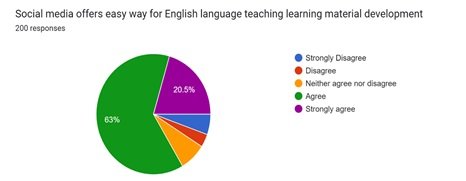
In response to the question statement that ‘Social media offers easy way for English language teaching learning material development’, the above chart shows the results of 200 responses 5-5.0% respondents respond with strongly disagree option, 2.0% respondents responded with the option disagree, 9.0% respondents responded with the option neither agree nor disagree, 63.0% respondents responded with the option agree and 20.5% respondents responded with the strongly agree. The results show that 7.5% respondents disagree with the statement, 83.5% respondents agree with the statement while 9.0% respondents remain neutral. The results confirm that majority of respondents agree that social media platforms is a smoth way for language learning and teaching in English for material development. That shows a positive sign for use of social media for English language learning and teaching material development.
Figure 5

Response to the question statement that ‘Social media is confusing for English language teaching learning material development’, the above chart shows the results of 200 responses 10.0% respondents respond with strongly disagree option, 57.0% respondents responded with the option disagree, 19.0% respondents responded with the option neither agree nor disagree, 2.5% respondents responded with the option agree and 11.5% respondents responded with the strongly agree. The results show that 67.0% respondents disagree with the statement, 14.0% respondents agree with the statement while 19.0% respondents remain neutral. The results confirm that majority of respondents disagree that social media is confusing for English language teaching and learning material development. That indicates a positive sign towards social media usage for English language teaching and learning material development.
Figure 6
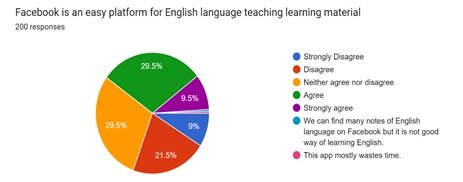
In response to the question statement that ‘Facebook is an easy platform for English language teaching learning material development’, the above chart shows the results of 200 responses 9.0% respondents respond with strongly disagree option, 21.5% respondents responded with the option disagree, 29.5% respondents responded with the option neither agree nor disagree, 29.5.0% respondents responded with the option agree and 10.5% respondents responded with the strongly agree. The findings answers that 30.5% participants conflict with the statement, 40.0% participants accede with the statement while 29.5% respondents remain unbaised. The results confirm that majority of respondents agree that Facebook is an easy platform for English language learning and teaching material development. This is a positive sign for the use of social media for English language teaching and learning material development.
Figure 7

In response to the question statement that ‘Whatsup is an easy platform for English language teaching learning material development’, the above chart shows the results of 200 responses 7.0% respondents respond with strongly disagree option, 20.0% respondents responded with the option disagree, 23.0% respondents responded with the option neither agree nor disagree, 37.5.0% respondents responded with the option agree and 12.0% respondents responded with the strongly agree and 0.5% added a new response. The results show that 27.0% respondents disagree with the statement, 49.5% respondents agree with the statement while 23.0% respondents remain neutral. The results confirm that majority of respondents agree that Whatsup is an easy platform for English language learning and teaching material development. This is a positive sign for the usage of social media for English language teaching and learning material development.
Figure 8
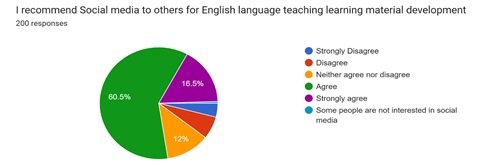
In response to the question statement that ‘I recommend social media for English language teaching learning material development’, above chart shows the results of 200 responses 3.0% respondents respond with strongly disagree option, 8.0% respondents responded with the option disagree, 12.0% respondents responded with the option neither agree nor disagree, 60.5% respondents responded with the option agree and 16.5% respondents responded with the strongly agree response. The results show that 11.0% respondents disagree with the statement, while 77.0% participants agree with the statement while 12.0% respondents remain neutral. The results confirm that majority of respondents agree to recommend social media for English language teaching and learning material development. This is a positive sign for using social media for English language learning and teaching material development.
Figure 9
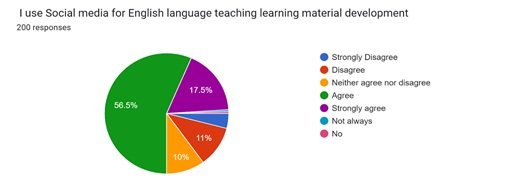
In response to the question statement that ‘I use social media for English language teaching learning material development’, that above chart shows the results of 200 responses 5.0% respondents respond with strongly disagree option, 11.0% respondents responded with the option disagree, 10.0% respondents responded with the option neither agree nor disagree, 56.5% respondents responded with the option agree and 17.5% respondents responded with the strongly agree response. The results show that 16.0% respondents disagree with the statement, 74.0% respondents agree with the statement while 10.0% respondents remain neutral. The results confirm that majority of respondents accept that they use social media platforms for English language learning and teaching material development. This is a positive sign for using social media for English language teaching and learning material development.
Figure 10
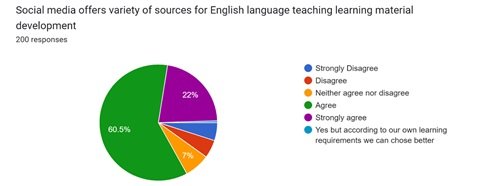
In response to the question statement that ‘Social media offers variety of sources for English language teaching learning material development’, the above chart shows the results of 200 responses 3.5% respondents respond with strongly disagree option, 7.0% respondents answered with the option disagree, 7.0% respondents responded with the option neither agree nor disagree, 60.5% respondents responded with the option agree and 22.0% respondents acknowledged with the strongly agree response. The results show that 10.5% respondents disagree with the statement, 82.5% respondents agree with the statement while 7.0% respondents remain neutral. The results confirm that majority of respondents accept that social media offers variety of sources for English language teaching and learning material development. This is a positive sign for using social media for English language teaching and learning material development.
Figure 11

In response to the question statement that ‘Social media helps to become independent for English language teaching learning material development’, the above chart shows the results of 200 responses 6.0% respondents respond with strongly disagree option, 8.5% respondents responded with the option disagree, 14.0% respondents responded with the option neither agree nor disagree, 55.5% respondents responded with the option agree and 16.0% respondents responded with the strongly agree response. The results show that 14.5% respondents disagree with the statement, 71.5% respondents agree with the statement while 14.0% respondents remain neutral. The results confirm that majority of respondents accept that social media helps to become independent for English language teaching and learning material development. That shows a positive sign for using social media for English language learning and teaching material development.
Figure 12
In response to the question statement that "social media helps to become independent for English language learning and teaching material development" the above chart shows the results of 200 responses 6.0% respondents respond with strongly disagree option, 9.0% respondents responded with the option disagree, 14.0% participants don't agree or disagree, 55.5% participants responded agree and 16.0% participants responded with the strongly agree response. The results show that 9.0% respondents disagree with the statement, 77.0% respondents agree with the statement while 14.0% respondents remain neutral. The results confirm that majority of respondents accept that social media helps to become independent for English language learning and teaching material development.
Figure 13
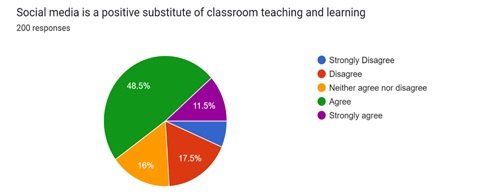
In response to the question statement that ‘Social media is a good source of teaching and learning English’, the above chart shows the results of 200 responses 2.0% respondents respond with strongly disagree option, 6.0% respondents responded with the option disagree, 9.0% participants don't agree or disagree, 58.5% participants responded agree and 24.5% participants responded with the strongly agree response. The results show that 8.0% respondents disagree with the statement, 83.0% respondents agree with the statement while 9.0% respondents remain neutral. The results confirm that majority of respondents accept that social media is a good source of teaching and learning English. This is a positive sign for using social media for the use of social media as a material development source for English language learning and teaching.
Figure 14
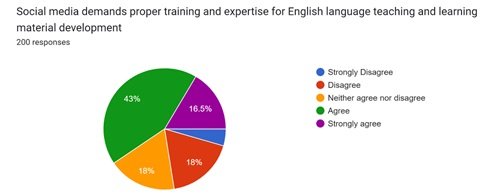
In response to the question statement that ‘Social media is a positive substitute of 6.5% respondents respond with strongly disagree option, 17.5% respondents responded with the option disagree, 16.0% respondents responded with the option neither agree nor disagree, 48.5% respondents responded with the option agree and 11.5% respondents responded with the strongly agree response. The results show that 24.0% respondents disagree with the statement, 60.0% participants agree with the statement while 16.0% respondents remain neutral. The results confirm that majority of respondents accept that social media is a positive substitute of classroom teaching and learning. This is a positive sign for using social media for English language teaching and learning material development.
Figure 15
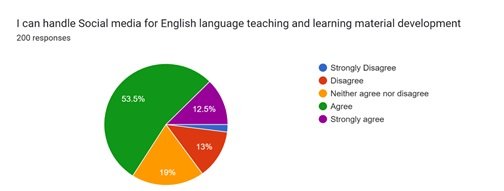
In response to the question statement that ‘Social media demands proper training and expertise for English language teaching and learning material development’, above chart shows the results of 200 responses 4.5% respondents respond with strongly disagree option, 18.0% respondents responded with the option disagree, 18.0% respondents responded with the option neither agree nor disagree, 43.0% respondents responded with the option agree and 16.5% respondents responded with the strongly agree response. The results show that 22.5% participants not agree with the statement, 59.5% participants agree with the statement while 18.0% respondents remain neutral. The results confirm that majority of respondents accept that social media demands proper training and expertise for English language learning and teachers material development. This is a positive sign for social media usage for learning and teaching English language for material development.
In response to the question statement that ‘Social media demands proper training and expertise for English language teaching and learning material development’, above chart shows the results of 200 responses 4.5% respondents respond with strongly disagree option, 18.0% respondents responded with the option disagree, 18.0% respondents responded with the option neither agree nor disagree, 43.0% respondents responded with the option agree and 16.5% respondents responded with the strongly agree response. The results show that 22.5% participants not agree with the statement, 59.5% participants agree with the statement while 18.0% respondents remain neutral. The results confirm that majority of respondents accept that social media demands proper training and expertise for English language learning and teachers material development. This is a positive sign for social media usage for learning and teaching English language for material development.
Figure 16
Figure 16
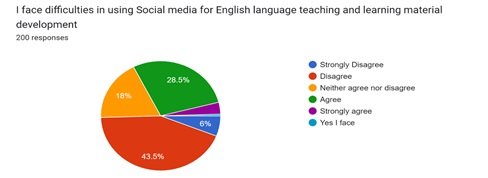
In response to the question statement that ‘I can handle social media for English language teaching and learning material development’, the above chart shows the results of 200 responses 2.0% respondents respond with strongly disagree option, 13.0% respondents responded with the option disagree, 19.0% respondents responded with the option neither agree nor disagree, 53.5% respondents responded with the option agree and 12.5% respondents responded with the strongly agree response. The results show that 15.0% respondents disagree with the statement, 66.0% respondents agree with the statement while 19.0% respondents remain neutral. The results confirm that majority of respondents accept that they can handle social media for English language learning and teaching material development. This is a positive sign for using social media for English language teaching and learning material development.
In response to the question statement that ‘I face difficulties while using social media for English language teaching and learning material development’, the above chart shows the results of 200 responses 4.0% respondents respond with strongly disagree option, 43.5% respondents responded with the option disagree, 18.0% respondents responded with the option neither agree nor disagree, 28.5% respondents responded with the option agree and 6.0% respondents responded with the strongly agree. The findings answers that 47.5% participants disagree with the statement, 34.5% respondents agree with the statement while 18.0% respondents remain neutral. The results confirm that majority of respondents do not face difficulties in the use of social media for English language teaching and learning material development. This is a positive sign for using social media for English language teaching and learning material development.
Qualitative Data Analysis of Interview Questions
Five Questions were asked from teachers and students. Here is a qualitative analysis of the interview questions.
The statement for Q. No. 1 was “How does social media benefit modern education scenario?” A greater number of the respondents agreed that social media is beneficial for the ELT settings at undergraduate levels in Pakistan.
The statement for Q. No. 2 was “How social media can be used as a source of teaching learning?” the majority of the respondent agreed that social media can be used for ELT material development purposes at undergraduate levels in Pakistan. The respondents confirmed that social media offers variety of teaching learning sources.
The statement for Q. No. 3 was “Why do you use social media for learning and teaching purposes?” A huge number of the respondent agreed that they used social media in ELT settings at undergraduate levels in Pakistan for the reason that modern education setting demand use of social media. The respondents confirmed that social media platforms are effective source of getting and sharing information in an academic setting.
The statement for Q. No. 4 was “Do you agree that social media is confusing and waste of time as teaching learning source?” the majority of the respondent disagreed that social media is confusing and waste of time in ELT settings at undergraduate levels in Pakistan. However, some respondents raised the point that it was a source of distracting and diverting the learners and resulted in waste of time and confusion.
The statement for Q. No. 5 was “What problems do you face in using social media for learning and teaching purposes?” A large number of respondent agreed that social media created some problems for them in ELT settings at undergraduate levels in Pakistan. The major problems they pointed out were poor web connections, costly web packages, cyber bullying, fake data and cheating opportunities. However, a good number of respondents felt comfortable for using social media for teaching learning purposes.
Results
The present study shows the findings that supports the idea that social media is an effective and modern source of information and teaching learning source in ELT classrooms. The results obtained from survey questionnaire and interview data analysis confirm the effectiveness of use of social media use as source of material development for ELT teachers and learners.
Discussion
The idea that social media can be used for ELT material development source is an indication of paradigm shift from traditional to modern teaching learning resource and a change from teacher dependence and only classrooms dependence to an open-ended teaching learning world.
Conclusion and Future Researches
The present study reached the conclusion that the role and place of use of social media for educational purposes in modern times is quite confirmed. Pakistani ELT settings when observed and analysed highlighted that ELT teachers and learners do face some problems and lack of proper training for usage of social media for English language teaching and learning purposes at undergraduate levels. It is not an age of dependence rather an era of being academically skilled and independent. The present study had proved the point that target of effective ELT teaching and learning can be achieved by using social media for material development purposes at undergraduate levels in Pakistan.
Findings
? Social media offers a positive substitute of traditional teaching learning approach as the world has shifted from traditional to digital world and teaching learning styles.
? Social media offers independent teaching learning opportunities on individual and collective levels.
? Use of social media for ELT material development purposes is not only a need of the hour but also a blessing with creatively and self-directed teaching and learning.
Recommendation
In light of the data analysis and findings the following recommendations can be made:
? It is recommended that use of social media for academic purposes has an undeniable significance in ELT settings at undergraduate level in Pakistan.
? It is recommended that the paradigm shift from traditional teachers and books dependence has taken place; therefore, the shift to digitalization should be accepted.
? It is recommended that the social media usage for English language teaching and learning purposes should not remain confined to seeking information only from social media platforms.
? It is recommended that the problems faced for using social media effectively and efficiently should be solved permanently.
? It is recommended that proper training for effective use of social media should be provided on institutional levels.
? It is recommended that customized material development of ELT material should be done by both the teachers and the learners.
References
- Abbas, J., Aman, J., Nurunnabi, M., & Bano, S. (2019). The Impact of Social Media on Learning Behavior for Sustainable Education: Evidence of Students from Selected Universities in Pakistan. Journal Sustainability, 11, 1-23.
- Akhiar, A., Mydin, A. A., & Kasuma, S. A. A. (2017). Students’ perceptions and attitudes towards the use of Instagram in English language writing. Education, 47, 72.
- Al-Jarrah, J. M., Talafhah, R. H., & Al-Jarrah, T. M. (2019). Social networking sites and English language learning: Jordanian EFL learners ‘practices and experiences. European Journal of English Language Teaching, 2(4), 91-100.
- Amin, B., Rafiq, R., & Mehmood, N. (2020), “The impact of social media in English language learningâ€, Journal of Critical Reviews, 7(10), 3126-3135,
- Babbie, E. R. (2015). The practice of social research. Nelson Education.
- Bhatti, A., Bano, T., & Rehman, S.-U. (2019), “Social media and consumer satisfaction effect on consumer purchase intention with the moderating role of trustâ€, International Journal of Business Management, 4(2), 131- 141.
- Bowley, R. C. (2009). ’A comparative case study: Examining the organizational use of social networking sites’, Thesis, The University of Waikato, Hamilton
- Gettman, H. J., & Cortijo, V. (2015). “Leave me and my Facebook alone!†Understanding college students’ relationship with Facebook and its use for academic purposes. International Journal for the Scholarship of Teaching and Learning, 9(1), 8.
Cite this article
-
APA : Hafeez, A., Majid, H. A., & Yousaf, S. (2023). Using Social Media as Material Development Source for English Language Teaching and Learning for ELT Classrooms at Undergraduate Levels. Global Social Sciences Review, VIII(I), 155-168. https://doi.org/10.31703/gssr.2023(VIII-I).15
-
CHICAGO : Hafeez, Amir, Hafiz Abdul Majid, and Saima Yousaf. 2023. "Using Social Media as Material Development Source for English Language Teaching and Learning for ELT Classrooms at Undergraduate Levels." Global Social Sciences Review, VIII (I): 155-168 doi: 10.31703/gssr.2023(VIII-I).15
-
HARVARD : HAFEEZ, A., MAJID, H. A. & YOUSAF, S. 2023. Using Social Media as Material Development Source for English Language Teaching and Learning for ELT Classrooms at Undergraduate Levels. Global Social Sciences Review, VIII, 155-168.
-
MHRA : Hafeez, Amir, Hafiz Abdul Majid, and Saima Yousaf. 2023. "Using Social Media as Material Development Source for English Language Teaching and Learning for ELT Classrooms at Undergraduate Levels." Global Social Sciences Review, VIII: 155-168
-
MLA : Hafeez, Amir, Hafiz Abdul Majid, and Saima Yousaf. "Using Social Media as Material Development Source for English Language Teaching and Learning for ELT Classrooms at Undergraduate Levels." Global Social Sciences Review, VIII.I (2023): 155-168 Print.
-
OXFORD : Hafeez, Amir, Majid, Hafiz Abdul, and Yousaf, Saima (2023), "Using Social Media as Material Development Source for English Language Teaching and Learning for ELT Classrooms at Undergraduate Levels", Global Social Sciences Review, VIII (I), 155-168
-
TURABIAN : Hafeez, Amir, Hafiz Abdul Majid, and Saima Yousaf. "Using Social Media as Material Development Source for English Language Teaching and Learning for ELT Classrooms at Undergraduate Levels." Global Social Sciences Review VIII, no. I (2023): 155-168. https://doi.org/10.31703/gssr.2023(VIII-I).15
